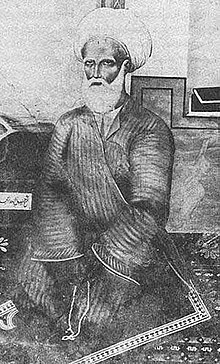Shaykh Ahmad
Shaykh Ahmad | |
|---|---|
 Ahmad Ibn Zayn al-Din al-Ahsáʼí | |
| Personal | |
| Born | May 1753 CE |
| Died | 27 June 1826 |
| Resting place | Jannaṫ al-Baqīʻ Cemetery, Medina, Hijaz (Present-day Saudi Arabia) |
| Religion | Islam |
| Era | Qajar Dyanasty |
| Denomination | Twelver Shia |
| Jurisprudence | Shaykhí, |
| Muslim leader | |
Influenced by | |
Shaykh Ahmad ibn Zayn al-Dín ibn Ibráhím al-Ahsá'í (Arabic: شيخ أحمد بن زين الدين بن إبراهيم الأحسائي) (1753–1826), commonly known as Shaykh Ahmad or al-Ahsá'í, was a prominent 19th-century Muslim theologian and jurist who founded the influential Shaykhí school of Twelver Shiism, which attracted followers from throughout the Persian and Ottoman Empires.
He was a native of the Al-Ahsa region (Eastern Arabian Peninsula), educated in Bahrain and the theological centers of Najaf and Karbala in Iraq.[1] Spending the last twenty years of his life in Iran, he received the protection and patronage of princes of the Qajar dynasty.[2]
Shaykh Ahmad's teachings diverged from the Usuli school on key issues related to eschatology, the role of the ulama, and the proper interpretation of the mystical hadith of the Twelve Imams. These divergences resulted in accusations of heresy from orthodox members of the Shia ulama, and instances of persecution against Ahsá'í and his followers occurred during and after his lifetime.
Today, Shaykhí populations retain a minority following in Iran and Iraq. After the death of Shaykh Ahmad's successor, Kazim Rashti, many Shaykhís converted to Bábism and the Baháʼí Faith; the two Shaykhí leaders continue to be highly regarded by Baháʼís, being seen as spiritual forerunners to that religion.
History
| Part of a series on Shia Islam |
| Twelver Shi'ism |
|---|
|
|
Early life
Little is documented about the early life of Shaykh Ahmad, except that he was born in al-Ahsa, in the northeast of the Arabian peninsula, to a Shiʻi family of Sunni origin in either the year 1166 AH (1753 CE), or 1157 AH (1744 CE). Nabíl's Narrative, a Baha'i history, describes his spiritual awakening as follows:
He observed how those who professed the Faith of Islam had shattered its unity, sapped its force, perverted its purpose, and degraded its holy name. His soul was filled with anguish at the sight of the corruption and strife which characterised the Shí'ah sect of Islam [...] Forsaking his home and kindred, on one of the islands of Bahrayn, to the south of the Persian Gulf, he set out, [...] to unravel the mysteries of those verses of Islamic Scriptures which foreshadowed the advent of a new Manifestation [...] There burned in his soul the conviction that no reform, however drastic, within the Faith of Islam, could achieve the regeneration of this perverse people. He knew, [...] that nothing short of a new and independent Revelation, as attested and foreshadowed by the sacred Scriptures of Islam, could revive the fortunes and restore the purity of that decadent Faith.
While it is unclear how much of Nabil's interpretation is consistent with Shaykh Ahmad's true feelings, the underlying motivations for reform, and ultimately for messianic expectation, become somewhat clearer.
Education and Mission
Shaykh Ahmad, at about age forty (1784 or 1794 - circa), began to study in earnest in the Shiʻi centres of religious scholarship such as Karbala and Najaf. He attained sufficient recognition in such circles to be declared a mujtahid, an interpreter of Islamic Law. He contended with Sufi and Neo-Platonist scholars, and attained a positive reputation among their detractors. He declared that all knowledge and sciences were contained (in essential form) within the Quran, and that to excel in the sciences, all knowledge must be gleaned from the Quran. To this end he developed systems of interpretation of the Quran and sought to inform himself of all the sciences current in the Muslim world.
He also evinced a veneration of the Imams, even beyond the extent of his pious contemporaries and espoused heterodox views on the afterlife, the resurrection and end-times, as well as medicine and cosmology. His views on the soul posited a "subtle body" separate from, and associated with the physical body, and this also altered his views on the occultation of the Imam Muhammad al-Mahdi. His views resulted in his denunciation by several learned clerics, and he engaged in many debates before moving on to Persia where he settled for a time in the province of Yazd. It was in Yazd that much of his books and letters were written.
Founding the Shaykhi School
Juan Cole summarizes the situation at the advent of the Shaykhi School, and the questions that were unfolding as his views crystallized and he acquired an early following:
When Shaykh Ahmad al-Ahsa'i wrote, there was no Shaykhi school, which only crystallized after his death. He saw himself as a mainstream Shiʻite, not as a sectarian leader. Yet he clearly innovated in Shiʻi thought in ways that, toward the end of his life, sparked great controversy. Among the contentious arenas he entered was that of the nature of religious authority. He lived at a time when his branch of Islam was deeply divided on the role of the Muslim learned man. Was he an exemplar to be emulated by the laity without fail, or merely the first among equals, bound by a literal interpretation of the sacred text just as was everyone else? Or was he, as the Sufis maintained, a pole channeling the grace of God to those less enlightened than himself? How may we situate Shaykh Ahmad al-Ahsa'i with regard to these contending visions of Shiʻi Islam?[3]
— Juan Cole, Shaykh Ahmad Al-Ahsaʾi on the Sources of Religious Authority
Moojan Momen in his Introduction to Shiʻi Islam (George Ronald, Oxford, 1985) states that many mujtahids were afraid that the Shaykh's preference for intuitive knowledge, which he claimed to obtain directly by inspiration from the Imams, would seriously undermine the authority of their position. Momen has some interesting and useful commentary on Shaykh Ahmad's doctrines and his succession during which the conflict with Shiʻi orthodoxy intensified.
Successor
Shaykh Ahmad appointed Kazim Rashti as his successor, who led the Shaykhí movement until his death.[4] He taught his students how to recognize the Mahdi and the Masih (the returned Jesus). After his death in 1843, many of his students spread out around Iraq and Iran to search for a new leader.
Published works
Shaykh Ahmad was a prolific writer, he is known to have completed 71 published works during his career, of which 354 contemporary manuscripts are known to be still extant.[5] Writing primarily in Arabic, his work spanned a wide array of literary forms. The largest number of his works consist of correspondence with other members of the ulama or his students, usually intended to expand upon a teaching advanced in another work, or provide answers to vexing questions of theology or jurisprudence. Treatises and lessons composed independently by al-Ahsáʼí make up a smaller number of his works, but tend to be longer than his correspondence and more commonly studied and reprinted. In keeping with Islamic and Persian literary and academic tradition, a large number of his works take the form of commentaries on Surahs from the Qurʼan, important Hadiths of Muhammad or the Imams, or writing by earlier mystical or theological writers.[6] The most comprehensive bibliography of Ahmad's known works identifies twelve wide subject areas addressed by individual works:
• Sharh al-Fawa'id. Lithographed. N.P. (Tabriz: 1856).
• Jawami' al-Kalim. Lithographed. N.P. (Tabriz: 1856-59).
• Sharh al-Masha'ir. Lithographed. N.P. (Tehran: 1861).
• Sharh al-'Arshiyya. Lithographed. N.P. (Tehran: 1861).
• Sharh al-Ziyara al-Jami'a al-Kabira. Chapkhaneh Sa'adat (Kirman: 1972), 4 Volumes.
• Rasa'il al-Hikma. Al-Da'ira al-'Alamiyya (Beirut: 1993).
Notes
- ^ Zarandi 1932, p. 2.
- ^ Zarandi 1932, p. 7.
- ^ Cole 2001.
- ^ Corbin 1977.
- ^ Momen 1991, p. 25.
- ^ Momen 1991, p. 170.
References
- Amir-Moezzi, Mohammad Ali. "Une absence remplie de présences. Herméneutiques de l'occultation chez les Shaykhiyya (Aspects de l'imamologie duodécimaine VII) ," in Bulletin of the School of Oriental and African Studies Vol. 64, No. 1. (2001), pp. 1–18.
- Cole, Juan R. I. (2001-08-30), "Shaykh Ahmad Al-Ahsaʾi on the Sources of Religious Authority", The Most Learned of the Shiʿa, Oxford University Press, pp. 82–92, doi:10.1093/acprof:oso/9780195137996.003.0006, ISBN 9780195137996, retrieved 2018-10-04
{{citation}}: Invalid|ref=harv(help) - Cole, Juan R.I. "The World as Text: Cosmologies of Shaykh Ahmad al-Ahsa'i," in Studia Islamica, No. 80. (1994), pp. 145–163.
- Corbin, Henry (1977). Spiritual Body and Selestial Earth: from Mazdean Iran to Shīʻite Iran. Translated by Pearson, Nancy. Princeton, N.J.: Princeton University Press. p. 351. ISBN 0691018839. OCLC 23769270.
{{cite book}}: Invalid|ref=harv(help) - Corbin, Henry. L'ecole Shaykhie en Theologie Shiʻite. Taban (Tehran: 1967).
- Corbin, Henry. En islam iranien. Galimard (Paris: 1972), vol. 4.
- MacEoin, Denis. S.V. "Ahsa'i, Shaikh Ahmad b. Zayn al-Din," in Encyclopaedia Iranica, 3 vols. - (London: Routledge and Kegan Paul, 1983 - ).
- MacEoin, Denis. The Messiah of Shiraz. Brill (Leyden, 2008).
- Hamid, Idris Samawi. The Metaphysics and Cosmology of Process According to Shaykh Ahmad al-Ahsa'i. (Ph.D. dissertation: State University of New York at Buffalo, 1998).
- Lambden, Stephen (May 26, 2016). "Twin Shining Lights, Part 1: Shaykh Ahmad ibn Zayn al-Din al-Ahsa'i". Lights of 'Irfán: Papers Presented at the 'Irfán Colloquia and Seminars. 17.
- Momen, Moojan (1985). An Introduction to Shiʻi Islam: The History and Doctrines of Twelver Shiʻism. Yale University Press. pp. 229. ISBN 0-300-03499-7.
{{cite book}}: Invalid|ref=harv(help) - Momen, Moojan (1991). "The Works of Shaykh Ahmad al-Ahsá'í: A Bibliography". Baháʼí Studies Bulletin. Monograph #1: 177.
{{cite journal}}: Invalid|ref=harv(help) - A.L.M, Nicolas (1910). Essai sur le cheikhisme. Paris, France: Paul Geuthner.
{{cite book}}: Invalid|ref=harv(help) - Rafati, Vahid (1979). The Development of Shaykhi Thought in Shiʻi Islam. Ph.D. dissertation, University of California, Los Angeles.
- Zarandi, Nabil (1932) [Written in 1887-88]. Nabíl's Narrative of the Early Days of the Baháʼí Revelation. Translated by Effendi, Shoghi (Hardcover ed.). Wilmette, Illinois, USA: Baháʼí Publishing Trust. ISBN 0-900125-22-5.
{{cite book}}: Invalid|ref=harv(help)
External links
- Sheykh Ahmad Ahsa'i, Iranica
- alabrar.com for more information about Shaykhi teachings. (This site is in the Arabic language.)
- Early Shaykhism - Some biographical notes, translations and studies
- Collected Works of Shaykh Ahmad al-Ahsa'i at H-Bahai Discussion Network


